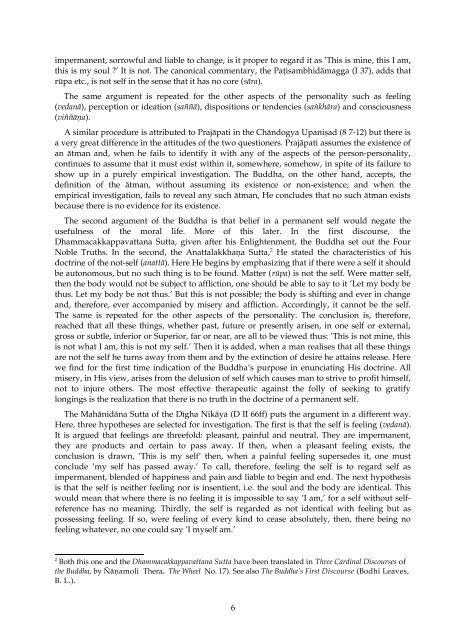The Truth of Anatta - Buddhist Publication Society
The Truth of Anatta - Buddhist Publication Society
The Truth of Anatta - Buddhist Publication Society
You also want an ePaper? Increase the reach of your titles
YUMPU automatically turns print PDFs into web optimized ePapers that Google loves.
impermanent, sorrowful and liable to change, is it proper to regard it as ’This is mine, this I am,<br />
this is my soul ’ It is not. <strong>The</strong> canonical commentary, the Paṭisambhidāmagga (I 37), adds that<br />
rūpa etc., is not self in the sense that it has no core (sāra).<br />
<strong>The</strong> same argument is repeated for the other aspects <strong>of</strong> the personality such as feeling<br />
(vedanā), perception or ideation (saññā), dispositions or tendencies (saṅkhāra) and consciousness<br />
(viññāṇa).<br />
A similar procedure is attributed to Prajāpati in the Chāndogya Upaniṣad (8 7-12) but there is<br />
a very great difference in the attitudes <strong>of</strong> the two questioners. Prajāpati assumes the existence <strong>of</strong><br />
an ātman and, when he fails to identify it with any <strong>of</strong> the aspects <strong>of</strong> the person-personality,<br />
continues to assume that it must exist within it, somewhere, somehow, in spite <strong>of</strong> its failure to<br />
show up in a purely empirical investigation. <strong>The</strong> Buddha, on the other hand, accepts, the<br />
definition <strong>of</strong> the ātman, without assuming its existence or non-existence; and when the<br />
empirical investigation, fails to reveal any such ātman, He concludes that no such ātman exists<br />
because there is no evidence for its existence.<br />
<strong>The</strong> second argument <strong>of</strong> the Buddha is that belief in a permanent self would negate the<br />
usefulness <strong>of</strong> the moral life. More <strong>of</strong> this later. In the first discourse, the<br />
Dhammacakkappavattana Sutta, given after his Enlightenment, the Buddha set out the Four<br />
Noble <strong>Truth</strong>s. In the second, the <strong>Anatta</strong>lakkhaṇa Sutta, 2 He stated the characteristics <strong>of</strong> his<br />
doctrine <strong>of</strong> the not-self (anattā). Here He begins by emphasizing that if there were a self it should<br />
be autonomous, but no such thing is to be found. Matter (rūpa) is not the self. Were matter self,<br />
then the body would not be subject to affliction, one should be able to say to it ’Let my body be<br />
thus. Let my body be not thus.’ But this is not possible; the body is shifting and ever in change<br />
and, therefore, ever accompanied by misery and affliction. Accordingly, it cannot be the self.<br />
<strong>The</strong> same is repeated for the other aspects <strong>of</strong> the personality. <strong>The</strong> conclusion is, therefore,<br />
reached that all these things, whether past, future or presently arisen, in one self or external,<br />
gross or subtle, inferior or Superior, far or near, are all to be viewed thus: ’This is not mine, this<br />
is not what I am, this is not my self.’ <strong>The</strong>n it is added, when a man realises that all these things<br />
are not the self he turns away from them and by the extinction <strong>of</strong> desire he attains release. Here<br />
we find for the first time indication <strong>of</strong> the Buddha’s purpose in enunciating His doctrine. All<br />
misery, in His view, arises from the delusion <strong>of</strong> self which causes man to strive to pr<strong>of</strong>it himself,<br />
not to injure others. <strong>The</strong> most effective therapeutic against the folly <strong>of</strong> seeking to gratify<br />
longings is the realization that there is no truth in the doctrine <strong>of</strong> a permanent self.<br />
<strong>The</strong> Mahānidāna Sutta <strong>of</strong> the Dīgha Nikāya (D II 66ff) puts the argument in a different way.<br />
Here, three hypotheses are selected for investigation. <strong>The</strong> first is that the self is feeling (vedanā).<br />
It is argued that feelings are threefold: pleasant, painful and neutral. <strong>The</strong>y are impermanent,<br />
they are products and certain to pass away. If then, when a pleasant feeling exists, the<br />
conclusion is drawn, ’This is my self’ then, when a painful feeling supersedes it, one must<br />
conclude ’my self has passed away.’ To call, therefore, feeling the self is to regard self as<br />
impermanent, blended <strong>of</strong> happiness and pain and liable to begin and end. <strong>The</strong> next hypothesis<br />
is that the self is neither feeling nor is insentient, i.e. the soul and the body are identical. This<br />
would mean that where there is no feeling it is impossible to say ’I am,’ for a self without selfreference<br />
has no meaning. Thirdly, the self is regarded as not identical with feeling but as<br />
possessing feeling. If so, were feeling <strong>of</strong> every kind to cease absolutely, then, there being no<br />
feeling whatever, no one could say ’I myself am.’<br />
2<br />
Both this one and the Dhammacakkappavattana Sutta have been translated in Three Cardinal Discourses <strong>of</strong><br />
the Buddha, by Ñāṇamoli <strong>The</strong>ra. <strong>The</strong> Wheel No. 17). See also <strong>The</strong> Buddha’s First Discourse (Bodhi Leaves,<br />
B. L.).<br />
6

















